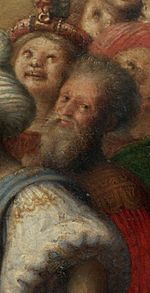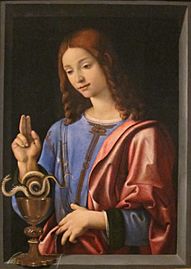Piero di Cosimo facts for kids
Quick facts for kids
Piero di Cosimo
|
|
|---|---|

Presumed self-portrait at the right side of his painting Perseus Freeing Andromeda
|
|
| Born | 2 January 1462 Florence, Republic of Florence
|
| Died | 12 April 1522 (aged 60) Florence, Republic of Florence
|
| Nationality | Italian |
| Education | Cosimo Roselli |
| Known for | Painting |
| Movement | High Renaissance |
Piero di Cosimo (born January 2, 1462 – died April 12, 1522) was an Italian painter. He was also known as Piero di Lorenzo. He lived during the Renaissance, a time of great art and learning in Europe.
Piero is best known for his paintings about myths and stories from ancient times. He created these works in the late 1400s. Later, he started painting more religious subjects. This change happened because of a powerful preacher named Savonarola in Florence. Savonarola also influenced another famous artist, Botticelli.
Even as new art styles appeared, Piero kept his unique way of painting. His figures looked very real, but he often added a playful or unusual touch to his subjects. This made his artworks special and interesting.
A writer named Giorgio Vasari wrote many stories about Piero's unusual habits. Piero also trained under an artist named Cosimo Rosselli. He even helped Rosselli paint frescos in the famous Sistine Chapel. Piero was also inspired by art from the Netherlands, which is why many of his paintings show detailed landscapes and forests. He was also known for designing decorations for big parties and festivals like Carnival.
Biography
Piero was born in Florence. His father, Lorenzo di Piero, was a goldsmith. Piero became an apprentice to the artist Cosimo Rosselli. This is how he got his popular name, "Piero di Cosimo," meaning "Piero of Cosimo." He helped Rosselli paint in the Sistine Chapel in 1481.
In his early career, Piero was influenced by Dutch painting. He especially liked the detailed natural style of Hugo van der Goes. Van der Goes's painting, the Portinari Triptych, helped change art in Florence. From this, Piero learned to love painting landscapes and showing tiny details of flowers and animals. You can see Hugo van der Goes's influence clearly in Piero's painting Adoration of the Shepherds.
In 1482, Piero traveled to Rome with his teacher, Rosselli. Piero showed himself to be a true artist of the Renaissance. He painted many scenes from Classical mythology. Some of these include Venus, Mars, and Cupid, The Death of Procris, and the Perseus and Andromeda series. These paintings show strange mixes of humans and animals. They also show early humans learning to use fire and tools. These ideas came from ancient writings by Vitruvius. The art of Luca Signorelli also influenced Piero's work.
Piero was known for being quite unusual. Stories about his strange habits were even written down by Giorgio Vasari in his book Lives of the Artists. For example, Piero was reportedly scared of thunderstorms. He also disliked cooking and rarely heated his food. Instead, he would boil 50 hard-boiled eggs at once while boiling glue for his art. He also didn't like cleaning his studio or trimming the fruit trees in his garden. Vasari wrote that he lived "more like a beast than a man," meaning he had very simple and wild habits.
Vasari said that Piero spent his last years living alone and sadly. This change might have been because of the preacher Girolamo Savonarola. Savonarola encouraged him to focus on religious art again. The death of his teacher, Rosselli, might also have made Piero sad in his later years. His paintings like Immaculate Conception with Saints and the Holy Family show his strong religious feelings.
Piero was also a very good portrait painter. One of his most famous portraits is of a noblewoman from Florence, Simonetta Vespucci. She was a well-known figure in Florence. Vasari also said that Piero was excellent at designing parades and celebrations for the young people of Florence. He described a lively parade from 1507 that showed the "triumph of death." Piero di Cosimo also taught other artists, including Andrea del Sarto.
Vasari wrote that Piero died in 1521, and many sources still repeat this date. However, old documents show that he actually died from the plague on April 12, 1522. Piero di Cosimo is also a character in the novel Romola by George Eliot.
Selected works
- Madonna and Child Enthroned with Sts. Peter, John the Baptist, Dominic, and Nicholas of Bari (1481–85) tempera and oil on panel, St. Louis Art Museum, St. Louis, Missouri
- Portrait of Simonetta Vespucci (c. 1480) Oil on panel, 57 x 42 cm, Musée Condé, Chantilly, France
- The Visitation with Saints Nicholas and Anthony (1489–1490) Wood, 184 x 189, National Gallery of Art, Washington
- Venus, Mars, and Cupid (1490) Wood panel, 72 x 182 cm, Staatliche Museen, Berlin
- Vulcan and Aeolus (c. 1490) Oil and tempera on canvas, National Gallery of Canada, Ottawa
- St Mary Magdalene (1490s) Tempera on panel, 72.5 x 76 cm, Galleria Nazionale d'Arte Antica, Rome
- Mystical Marriage of St. Catherine of Alexandria (1493) Oil on panel, Ospedale degli Innocenti, Florence
- Jason and Queen Hypsipyle with the Women of Lemnos (ca 1499) Private Collection
- Tritons and Nereids, Oil on Panel, 37x158 cm, Milan, Altomani collection
- Allegory (1500) Panel, National Gallery of Art, Washington
- The Nativity with The Infant St. John (c. 1500) Oil on panel, National Gallery of Art, Washington
- St. John the Evangelest (1504–06) Oil on panel, Honolulu Museum of Art
- The Discovery of Honey by Bacchus (c. 1505–1510) Oil on panel, Art Museum, Worcester, Massachusetts
- The Finding of Vulcan on Lemnos (1495–1505) Oil and tempera on canvas, Wadsworth Atheneum, Hartford, Connecticut
- Perseus Freeing Andromeda (c. 1515) Oil on wood, 70 x 123 cm, Uffizi, Florence
- Portraits of Giuliano and Francesco Giamberti da Sangallo (c. 1485) Diptych, wood panel, 47.5 x 33.5 cm, Rijksmuseum, Amsterdam
- The Death of Procris (c. 1500) Oil on panel, 65 x 183 cm, National Gallery, London
- Virgin with Child, St. John the Baptist and an Angel (c. 1500–1510) Oil on panel, diameter 129 cm, São Paulo Museum of Art, São Paulo
- The Adoration of the Christ Child (1505) Oil on wood, Galleria Borghese, Rome
- The Forest Fire (c. 1505) Oil on panel, 71 x 202 cm, Ashmolean Museum, Oxford
- Immaculate Conception with Saints (c. 1510 or c. 1498) Wood panel, 206 x 172 cm, Uffizi, Florence
- The Misfortunes of Silenus (c. 1505–1510) Oil on panel, Fogg Art Museum, Cambridge, Massachusetts
- The Myth of Prometheus (1515) Oil on panel, Alte Pinakothek, Munich and Musée des Beaux-Arts, Strasbourg
- The Building of a Palace (1515–20) oil on panel, 83 x 197 cm, Ringling Museum of Art, Sarasota, Florida
- Madonna and Child with Saints and Angels (c. 1520) oil on wood panel, Philbrook Museum of Art, Tulsa, Oklahoma
Gallery
-
St. John the Evangelist, oil on panel, 1504-6, Honolulu Museum of Art,
-
Visitation, with Saints Nicolas and Anthony Abbot, c. 1490, National Gallery of Art, Washington DC
Images for kids
-
PROMULGATIO LEGIS SCRIPTE PER MOISEM – fresco by Cosimo Rosselli
See also
 In Spanish: Piero di Cosimo para niños
In Spanish: Piero di Cosimo para niños






